Introduction:
Volcanoes, magnificent and awe-inspiring, are among Earth’s most fascinating natural phenomena. They are not just mere mountains; they are windows into the inner workings of our planet. These fiery giants hold the power to both create and destroy, playing a pivotal role in Earth’s geological and ecological dynamics. From the fiery eruptions that light up the sky to the fertile soils they leave in their wake, volcanoes are a testament to the ever-changing nature of our planet.
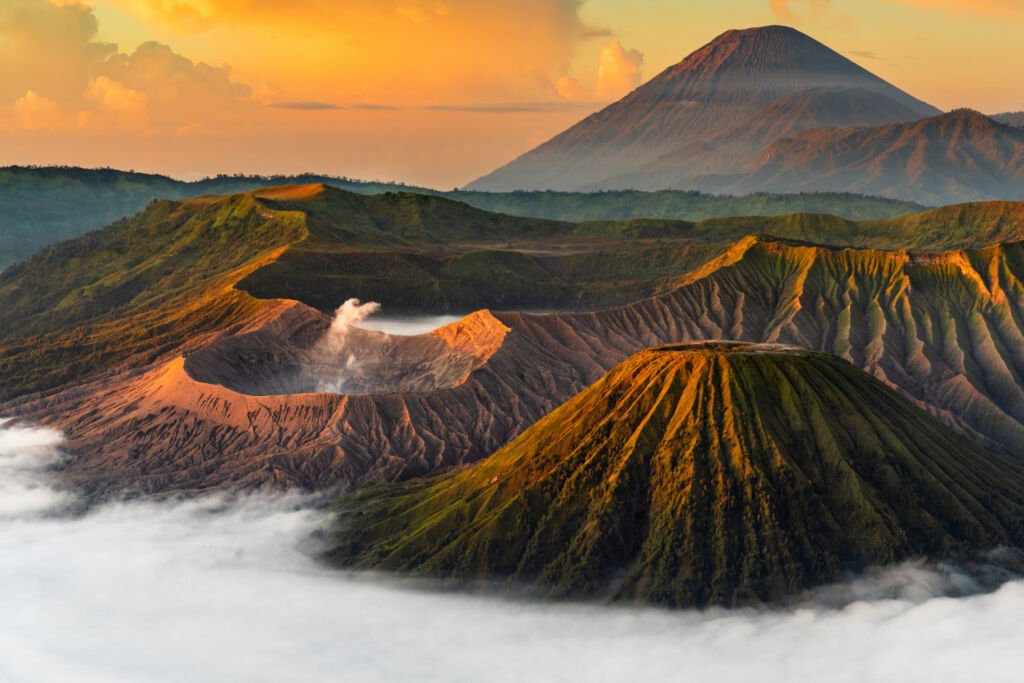
Volcanoes stand as some of the most compelling symbols of Earth’s dynamic nature. These formidable structures are not just mountains spewing lava but are profound evidence of the planet’s ongoing geological evolution. Our journey through the world of volcanoes is a journey into the heart of Earth’s inner workings, revealing the intricate balance between the forces that build our world and those that tear it apart.
Definition:
A volcano is a geological formation that occurs when magma, which is molten rock from beneath the Earth’s crust, rises to the surface. Once it reaches the surface, the magma is referred to as lava. Volcanoes typically take the form of a mountain or hill with a crater or vent through which the lava, volcanic ash, and gases are expelled.
Volcanoes are often found at the junction of tectonic plates, where Earth’s crustal plates move and interact, although they can also form over hotspots, areas where the mantle is particularly hot.
What Is Volcanology?
Volcanology is the scientific study of volcanoes and volcanic phenomena. Volcanologists are the scientists who specialize in volcanology. Volcanology encompasses the investigation and analysis of –
◆ Volcanic Eruptions:
Understanding the causes and mechanisms of volcanic eruptions, including the study of magma (molten rock) composition and dynamics, and the processes that lead to the eruption of lava, ash, and gases.
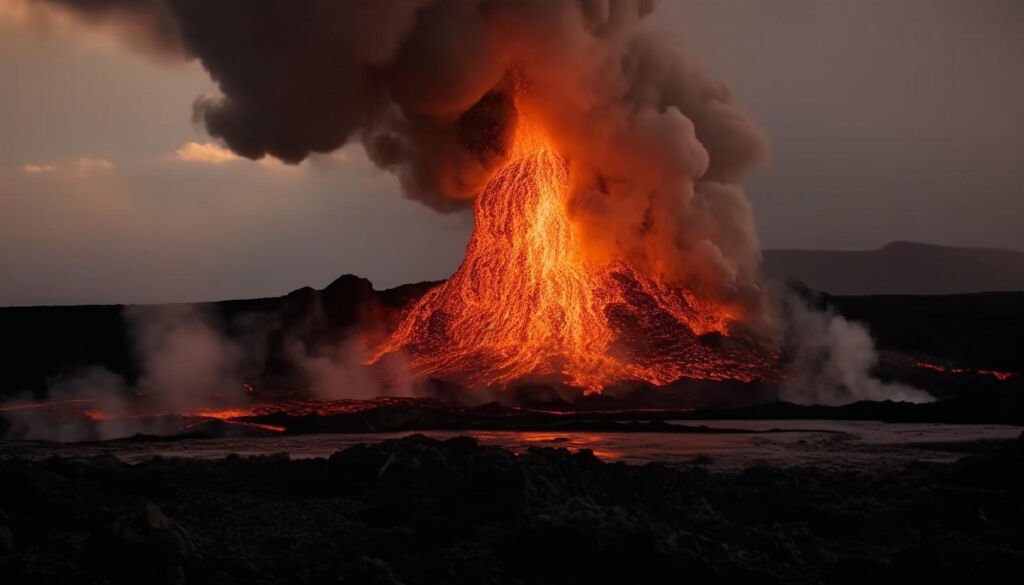
◆ Volcano Formation:
To research how volcanoes are formed, including the geological processes that lead to the development of volcanic structures on Earth’s surface.
◆ Volcanic Features and Landforms:
Studying the various forms and structures associated with volcanoes, such as calderas, volcanic cones, and lava flows.
◆ Volcanic Hazards and Risks:
Assessing the potential dangers volcanoes pose to human populations and the environment, including lava flows, ashfall, pyroclastic flows, volcanic gases, and tsunamis generated by volcanic activity.
◆ Prediction and Monitoring:
Develop methods to predict volcanic eruptions and monitor volcanic activity using seismology, satellite imagery, gas sampling, and other geophysical and geochemical techniques.
◆ Volcanic Impact on Climate and Environment:
Analyzing how volcanic eruptions impact the Earth’s climate and environment, including the effect of volcanic gases and ash on the atmosphere and climate systems.
Formation of Volcanoes:
The formation of it begins deep within the Earth. It starts with the melting of rock in the mantle (a layer beneath the Earth’s crust) due to high pressure and temperature. This melted rock, or magma, is less dense than the surrounding solid rock, causing it to rise towards the Earth’s surface. When this magma finds its way to the surface through cracks in the Earth’s crust, a volcano is born.
Volcanoes are formed through a series of geological processes that involve the movement of magma (molten rock) within the Earth and its eventual eruption onto the surface. The formation of a volcano typically follows these steps:
1. Magma Generation:
Volcanoes begin with the creation of magma. This occurs in the Earth’s mantle, the layer beneath the crust, due to various processes such as the melting of rock under high pressure and temperature conditions. This melting can happen in different ways:
- At divergent plate boundaries, where tectonic plates move apart, the pressure is reduced on the underlying rocks, leading to partial melting.
- At convergent plate boundaries, where one plate is forced below another into the mantle (a process known as subduction), the descending plate releases water, lowering the melting point of the overlying mantle and creating magma.
- In ‘hotspots’, which are plumes of hot material that rise from deep within the mantle, the heat can partially melt the crust, forming magma.
- Magma Ascent: Once formed, magma rises towards the Earth’s surface because it is less dense than the surrounding solid rock. The magma moves through cracks and fissures in the Earth’s crust. This movement can be facilitated by the buildup of pressure and the presence of volatile gases within the magma.
2. Volcano Formation:
As magma reaches closer to the Earth’s surface, it begins to form a pool in a magma chamber. Over time, with repeated magma injections, this chamber grows, and the pressure of the magma can cause the overlying rock to crack and fracture. This creates a conduit for the magma to travel through.
3. Volcanic Eruption:
When the pressure from the gases within the magma becomes too great, an eruption can occur. Magma is expelled onto the Earth’s surface, now called lava. Along with lava, volcanoes also emit gases and ash. The nature of the eruption (explosive or effusive) depends on factors like magma composition, temperature, and gas content.

3. Volcano Growth:
With each eruption, material accumulates around the vent. Over time, this accumulation can grow into a mountain or hill, forming the recognizable shape of a volcano. The shape and size of the it depend on the type of lava and eruption style – whether it’s fluid lava that spreads out over a wide area or more viscous lava that piles up around the vent.
3. Continuous Activity and Dormancy:
Volcanoes can go through periods of activity (eruptions) and dormancy (inactivity). Over geologic time, they can become extinct if there’s no longer a source of magma feeding them.
Causes of Volcanism:
The causes of volcanism are rooted in geological processes deep within the Earth. These can be summarized pointwise as follows:
1. Tectonic Plate Movements:
Divergent Plate Boundaries: At places where tectonic plates are moving apart, such as at mid-ocean ridges, the decrease in pressure allows the mantle to melt, producing magma.
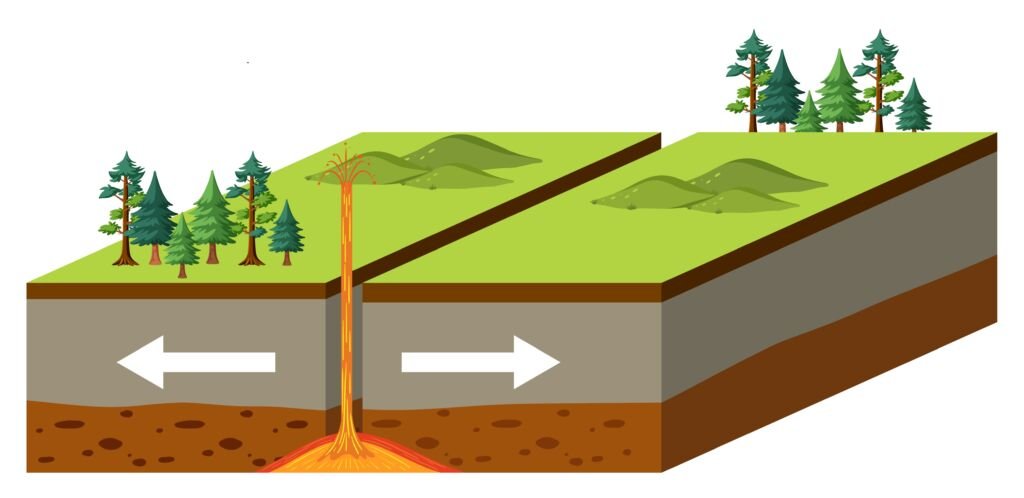
Convergent Plate Boundaries: Where one tectonic plate subducts beneath another, the descending plate releases water into the overlying mantle, lowering the melting point and generating magma. This is common along continental and oceanic collision zones.
Transform Plate Boundaries: Although less common, volcanism can also occur along transform boundaries due to the fracturing of the crust, which can allow magma to reach the surface.
2. Hotspots:
These are areas where plumes of hot mantle material rise towards the Earth’s surface independently of tectonic plate boundaries. The heat from these plumes can partially melt the overlying mantle and crust, creating magma. The Hawaiian Islands are a classic example of hotspot volcanism.
3. Mantle Plumes:
Similar to hotspots, mantle plumes are upwellings of abnormally hot rock within the Earth’s mantle. As the plume head ascends, it melts due to the decrease in pressure, forming magma.
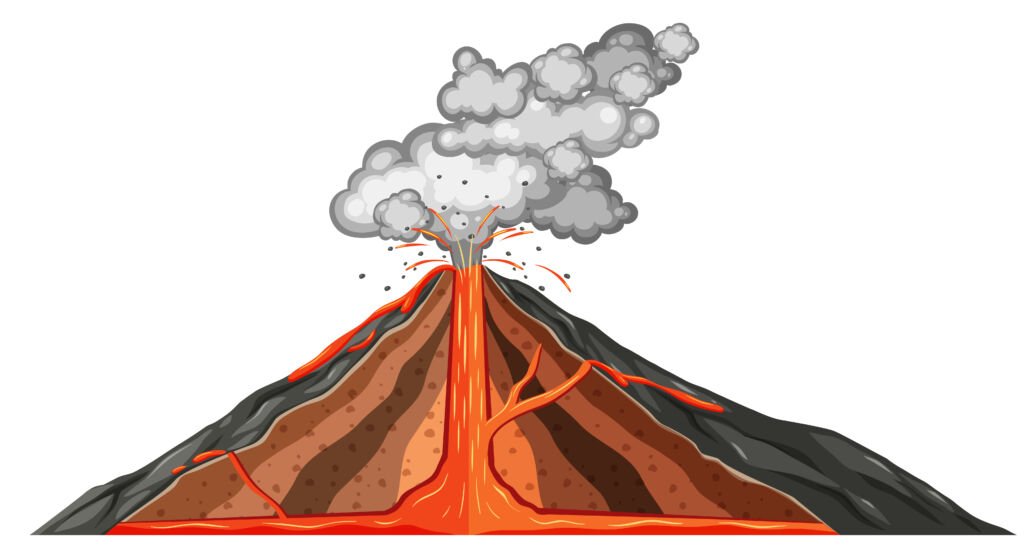
4. Crustal Extension:
In areas where the Earth’s crust is being pulled apart, such as in rift valleys, the thinning of the crust can allow decompression melting of the mantle, leading to magma formation.
5. Subduction-Related Processes:
Beyond water release, subducting plates can also contribute to magma formation through the introduction of subducted materials like sediments into the mantle, which can lower the melting point.
6. Volatiles in Magma:
The presence of volatiles (like water, carbon dioxide, and sulfur dioxide) in magma can significantly lower its melting point, facilitating the generation of magma.
7. Lithospheric Pressure Changes:
Changes in pressure within the Earth’s lithosphere, due to factors like tectonic uplift or erosion, can affect the melting point of the mantle and crust, leading to magma formation.
8. Intraplate Stresses:
Even away from plate boundaries, stresses within a tectonic plate can cause fracturing and melting in the crust and upper mantle, leading to volcanic activity.
9. Continental Collision Zones:
In some cases, when continents collide, the crust can thicken and eventually melt due to the high temperatures in the lower crust, creating magma.
These geological processes illustrate the dynamic nature of the Earth’s interior and its surface, leading to the varied and often spectacular phenomenon of volcanism.
Anatomy of a Volcano:
The anatomy of a volcano involves several key structures, each playing a specific role in its formation and eruption.
1. Magma Chamber:
Located beneath the surface, this is the reservoir of molten rock (magma) that feeds a volcano.
2. Vent:
The vent is a channel through which magma travels from the magma chamber to the Earth’s surface.
3. Crater:
Typically found at the summit of the volcano, the crater is a bowl-shaped depression formed by the eruptions.
4. Lava Flows:
When magma reaches the surface, it becomes lava. Lava flows are streams of this molten rock that spill out of the vent and move away from the volcano.
5. Volcanic Cone:
This is the mound that builds up around the vent due to the accumulation of volcanic material, like lava, ash, and rock fragments.
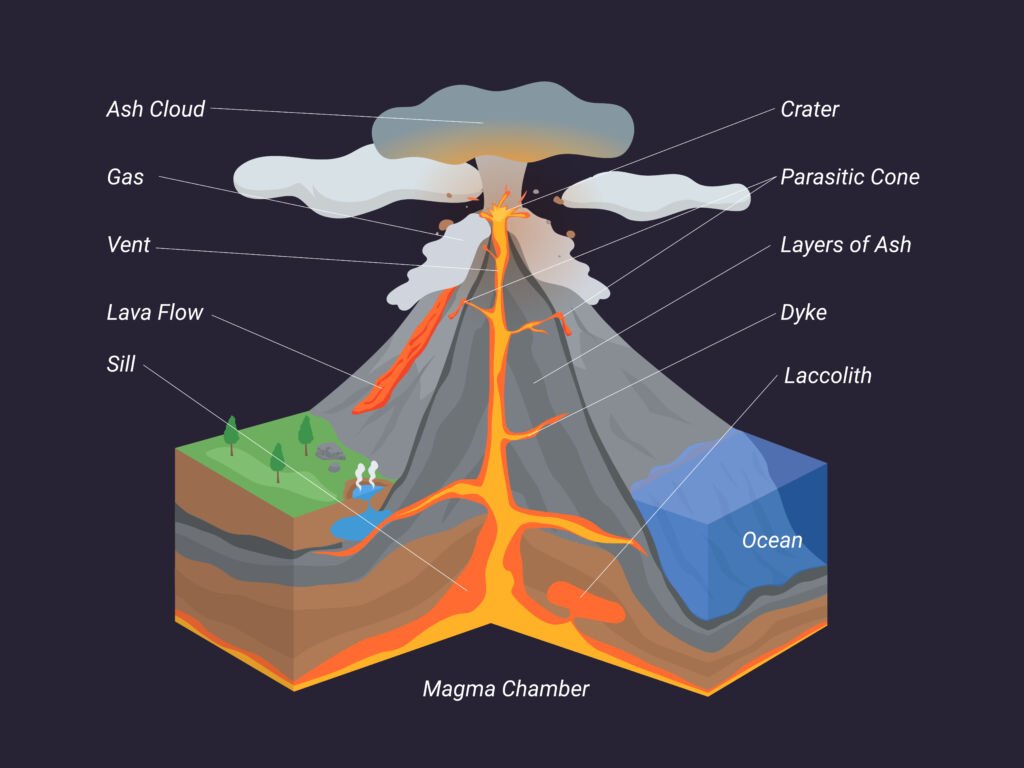
6. Ash Cloud:
Composed of fine volcanic particles, ash clouds can be ejected high into the atmosphere during an eruption.
7. Pyroclastic Flow:
These are fast-moving currents of hot gas and volcanic material (like ash and pumice) that can flow down the sides of a volcano during explosive eruptions.
8. Secondary Vents and Cones:
Some volcanoes have additional openings from which lava and ash are expelled.
9. Sill and Dike:
These are formations of hardened magma. A sill is a sheet of magma that has intruded between older layers of rock, while a dike is a similar formation that cuts across older rock formations.
10. Fumaroles:
These are openings near a volcano’s surface from which volcanic gases are emitted.
11. Caldera:
Larger than craters, calderas are massive depressions formed when a magma chamber empties and the volcano’s summit collapses into it.
World Distribution of Volcanoes:
Volcanoes are distributed globally, with significant concentrations in specific regions due to various geological processes. The most notable region is the “Ring of Fire” in the Pacific Ocean, but volcanic activity is by no means limited to this area. Here’s an elaboration, with examples, on where volcanoes are predominantly found:
1. Ring of Fire in the Pacific Ocean:
The “Ring of Fire” is a horseshoe-shaped belt running around the edge of the Pacific Ocean, characterized by a high level of seismic and volcanic activity. This area is home to over 75% of the world’s active and dormant volcanoes
The “Ring of Fire” is primarily the result of the movement and interactions of several major tectonic plates, including the Pacific Plate, the North American Plate, the Eurasian Plate, and others.
Many of these volcanoes are formed at convergent plate boundaries where oceanic plates subduct beneath continental plates, leading to magma generation and volcanic activity.
Examples: Mount St. Helens in the USA, Mount Fuji in Japan, and Mount Pinatubo in the Philippines.
2. Submarine Volcanoes:
A significant number of volcanoes exist beneath the oceans, known as submarine volcanoes.
These volcanoes often form along mid-ocean ridges, which are divergent plate boundaries where new oceanic crust is formed as tectonic plates pull apart.
Submarine volcanoes can also occur over hotspots, producing seamounts and island chains such as the Hawaiian Islands.
Example: The Mid-Atlantic Ridge, where Iceland is a surface expression of such volcanism.
3. Hotspots:
Occur away from plate boundaries, where plumes of hot mantle material rise toward the surface.
These hotspots remain stationary while tectonic plates move over them, creating chains of volcanoes.
Examples: the Hawaiian Islands (Hawaii’s Mauna Loa and Kilauea) and the Yellowstone Caldera in the USA.
4. Divergent Plate Boundaries:
Apart from mid-ocean ridges, divergent boundaries on continents can also form volcanic zones.
These areas see the formation of rift valleys and volcanism due to thinning and fracturing of the crust.
Example: The East African Rift system, featuring volcanoes like Mount Kilimanjaro and Mount Nyiragongo.
5. Convergent Plate Boundaries:
Where an oceanic plate subducts beneath a continental or another oceanic plate, creating volcanic arcs.
These areas are prone to explosive volcanic eruptions due to the water-rich magma.
Example: The Andes mountain range in South America with volcanoes like Cotopaxi and Mount Villarrica.
6. Submarine Volcanoes:
These are under-ocean volcanoes, many of which are located along mid-ocean ridges.
Some can form islands when their tops breach the ocean surface.
Example: Loihi Seamount, an underwater volcano near the Hawaiian Islands.
7. Polar Regions:
Volcanic activity is not limited to tropical or temperate zones; it also occurs in polar regions.
These volcanoes can impact ice sheets and contribute to glacial melting.
Example: Mount Erebus in Antarctica, one of the southernmost active volcanoes on Earth.
This global distribution of volcanoes highlights the dynamic nature of Earth’s geology, showcasing how plate tectonics and mantle dynamics shape our planet’s surface, even in the most remote locations.
⫸ Types of Volcanoes:
Volcanoes are classified based on size and shape, type of magma, frequency of eruption, etc.
1. Based on Shape and Size:
Volcanoes come in various types, each characterized by unique features and eruption styles. The primary types of volcanoes are:
a. Shield Volcanoes:
These are large, broad volcanoes with gently sloping sides.
Formed primarily by the eruption of low-viscosity lava that can flow long distances.
Eruptions are typically less explosive and more effusive, producing large volumes of lava.
Examples: Mauna Loa and Kilauea in Hawaii.
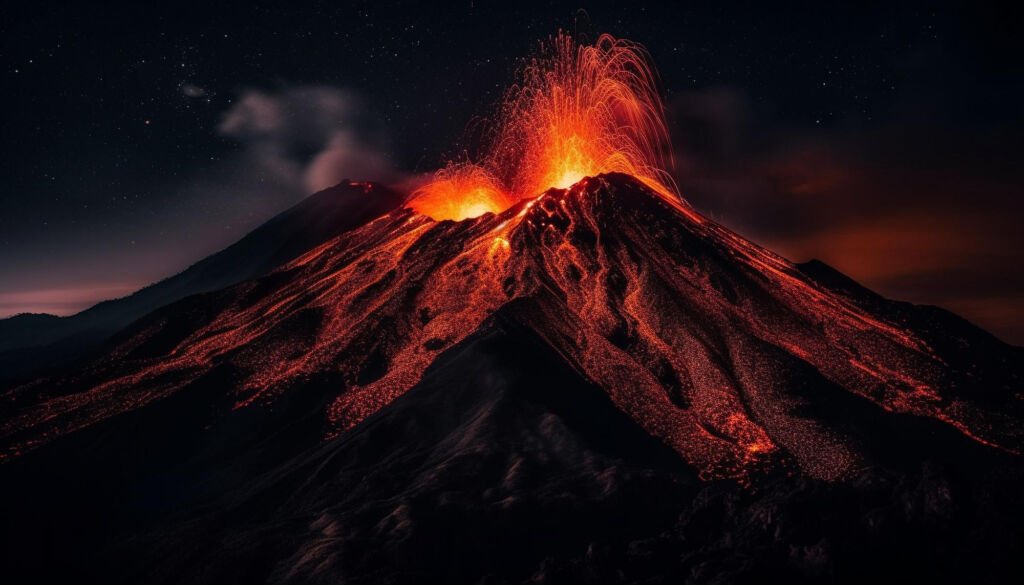
b. Stratovolcanoes (Composite Volcanoes):
Stratovolcanoes are characterized by their steep, conical shape with a crater at the summit.
Composed of many layers of hardened lava, tephra, pumice, and volcanic ash.
These volcanoes often have explosive eruptions due to the high viscosity of their magma.
Examples: Mount St. Helens in the USA and Mount Fuji in Japan
c. Cinder Cone Volcanoes:
Smaller than other types, cinder cones are steep, conical hills made up of volcanic debris known as cinders.
They result from eruptions where lava is thrown into the air and breaks into small fragments that fall around the vent.
Eruptions tend to be short-lived and not as large or violent as those from stratovolcanoes.
Example: Parícutin in Mexico.
d. Lava Dome Volcanoes:
Formed by the slow eruption of highly viscous lava.
Lava domes grow over time, with lava accumulating around the vent.
They are often found within the craters or on the flanks of stratovolcanoes.
Example: The Lassen Volcanic Center in California
e. Super Volcanoes:
Supervolcanoes are a less common type, characterized by their capacity to produce extremely large and catastrophic eruptions.
They often form calderas, large depression craters, when the magma chamber below them empties and collapses.
Example: Yellowstone Caldera in the USA.
f. Submarine Volcanoes:
Located beneath the ocean’s surface, these volcanoes often form along mid-ocean ridges or over hotspots.
They can create seamounts and eventually islands if the volcanic activity is persistent and significant.
Example: The submarine volcano Loihi, near Hawaii.
g. Subglacial Volcanoes:
These volcanoes form under ice caps or glaciers.
Their interaction with ice can lead to explosive steam eruptions and the creation of unique landforms like tuyas.
Example: Katla in Iceland.
2. Based on the Type of Magma:
Volcanoes can be classified based on the type of magma that feeds their eruptions, which largely determines the nature of the eruption and the shape of the volcano. Magma types are typically characterized by their silica content and viscosity. Based on these, volcanoes can be categorized into three primary types:
a. Basaltic Volcanoes:
Magma Characteristics: Basaltic magma has a low silica content (about 50%) and low viscosity (it’s relatively fluid).
Eruption Style: These volcanoes tend to have non-explosive, effusive eruptions. The lava flows easily and can cover large areas.
Volcano Types: Shield volcanoes are typically associated with basaltic magma, exemplified by the volcanoes in Hawaii.
Example: Mauna Loa in Hawaii.
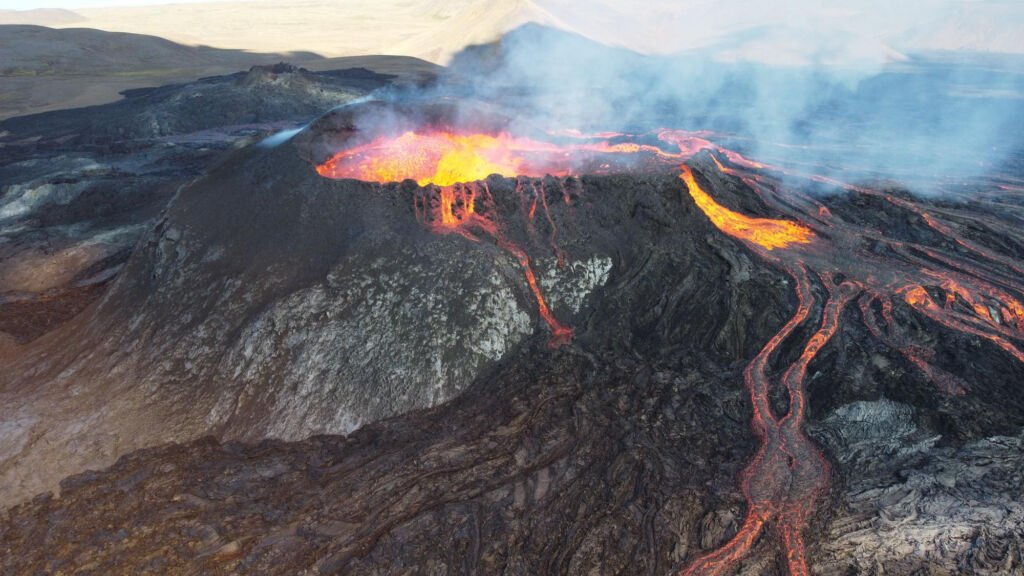
b. Andesitic Volcanoes:
Magma Characteristics: Andesitic magma contains a moderate silica content (about 60%) and has a higher viscosity than basaltic magma.
Eruption Style: The higher viscosity leads to more explosive eruptions compared to basaltic volcanoes. Andesitic lava does not flow as easily, often creating steep-sided volcanoes.
Volcano Types: Most stratovolcanoes or composite volcanoes are associated with andesitic magma.
Example: Mount St. Helens in the United States and Mount Fuji in Japan.
c. Rhyolitic Volcanoes:
Magma Characteristics: Rhyolitic magma has a high silica content (over 70%) and is very viscous.
Eruption Style: These volcanoes are prone to extremely explosive eruptions due to the high gas content and the magma’s inability to flow easily.
Volcano Types: Rhyolitic volcanoes often form lava domes; however, they can also result in the formation of calderas due to massive eruptions.
Example: Yellowstone Caldera in the United States.
The type of magma not only influences the style of volcanic eruptions but also significantly impacts the resultant landforms and the potential hazards associated with these volcanoes. For instance, the more explosive andesitic and rhyolitic volcanoes pose greater risks to nearby populations due to their explosive nature and the pyroclastic materials they can eject.
3. Based on the Frequency of Eruptions:
Volcanoes can be classified based on the frequency of their eruptions, which indicates their current activity status. This classification helps in understanding and monitoring volcanic hazards. The categories are –
a. Active Volcanoes:
These are volcanoes that have erupted recently and have a significant likelihood of erupting again.
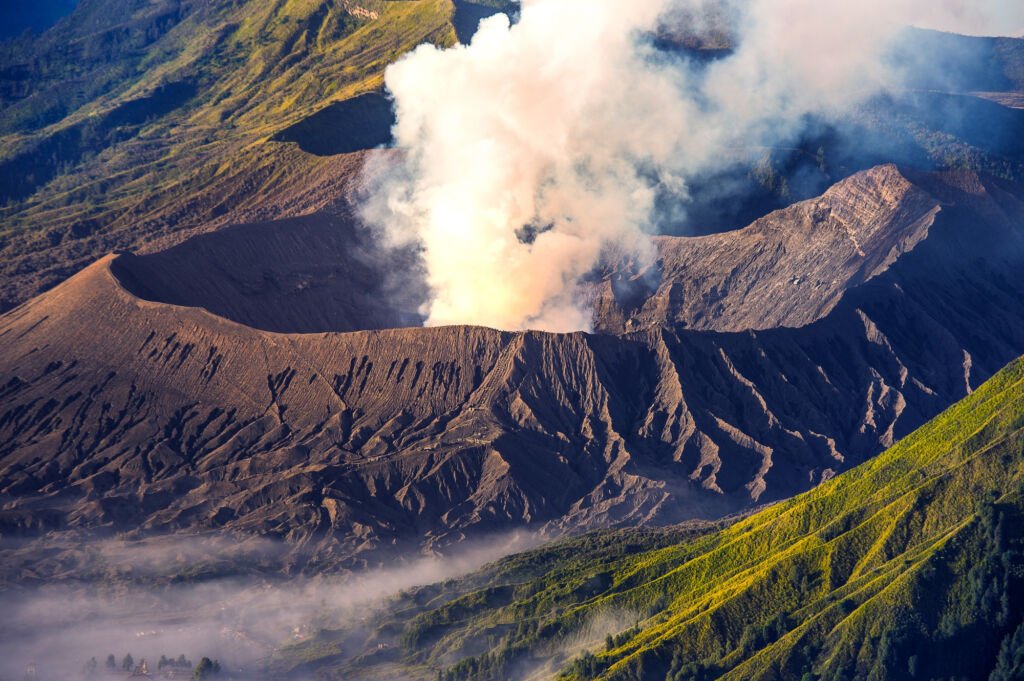
The term “recently” in a geological sense can vary, but it usually means they have erupted within historical times (the past few thousand years).
Examples: Mount Etna in Italy and Kīlauea in Hawaii.
b. Dormant Volcanoes:
Dormant volcanoes are those that have not erupted in recent history but are not extinct.
They show signs of potential activity, like seismic activity or gas emissions, indicating they could erupt again.
A famous example is Mount Rainier in the United States, which has not erupted for over a century but is considered potentially active
c. Extinct Volcanoes:
Extinct volcanoes are those that geologists believe will not erupt again.
This assessment is based on factors like the lack of recent activity, no recorded eruptions in historical times, and tectonic changes that would prevent the rise of magma.
Example: Kilimanjaro in Tanzania.
⫸ Tools Used to Monitor Volcanism:
Various types of equipment and instruments are used by volcanologists to measure and monitor volcanic activity. These tools help in predicting eruptions and understanding the complex processes of volcanism:
a. Seismometers:
Detect and record seismic waves generated by earthquakes and tremors, which often precede and accompany volcanic eruptions.

Changes in seismic activity can indicate the movement of magma within a volcano.
b. Gas Spectrometers:
Measure the types and amounts of gases (like sulfur dioxide, carbon dioxide, and water vapor) emitted by a volcano.
Changes in gas composition can signal a change in volcanic activity.
c. Thermal Imaging Cameras:
Detect and measure heat emitted from a volcano.
Useful in monitoring changes in the temperature of a volcano’s surface, which can indicate rising magma.
d. Tiltmeters and GPS Devices:
Measure very slight changes in the slope or deformation of a volcano’s surface.
Ground deformation is a key indicator of magma accumulation beneath a volcano.
e. Infrasound Sensors
Detect low-frequency sound waves produced by volcanic eruptions.
These sensors can pick up explosive eruptions even at great distances.
f. Synthetic Aperture Radar (SAR):
Used in satellites to detect ground deformation from space.
SAR can provide comprehensive coverage of a volcano’s surface, which is especially useful for remote or inaccessible volcanoes.
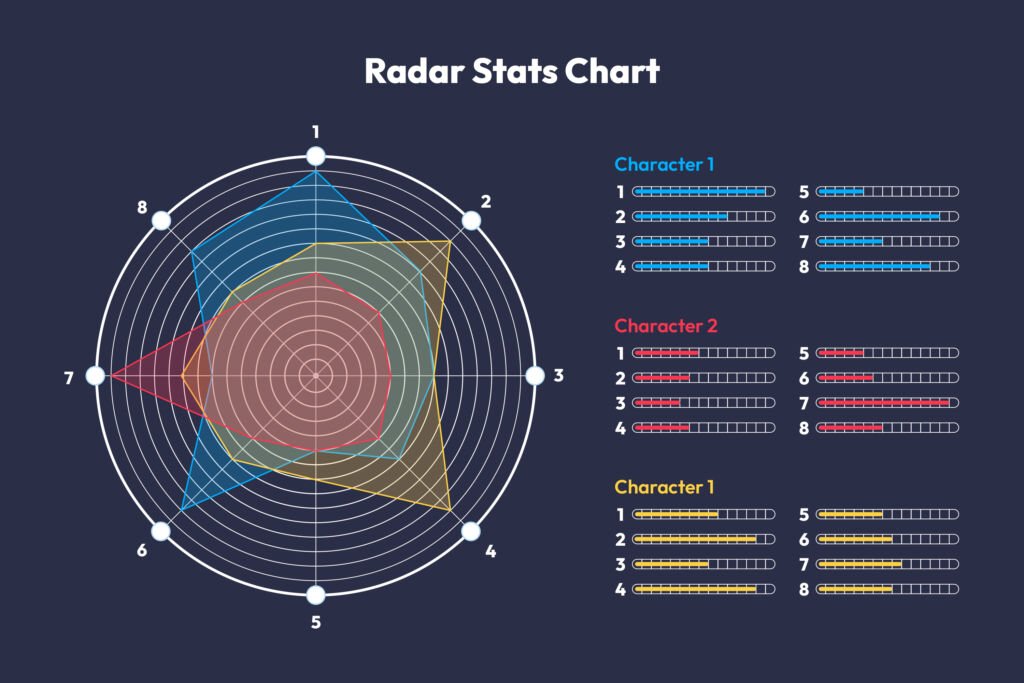
g. Photogrammetry:
Uses photographs from ground-based or aerial sources to create 3D models of a volcano’s surface.
Can track changes in the volcano’s shape and growth over time.
h. Lahar and Pyroclastic Flow Sensors:
Detect and monitor the flow of lahars (volcanic mudflows) and pyroclastic flows.
Often placed along potential flow paths to provide early warning.
i. Hydrologic Instruments:
Monitor changes in water chemistry and temperature in streams and lakes around volcanoes.
Changes can indicate volcanic activity affecting groundwater.
j. Volcanic Ash Sampling:
Collecting and analyzing volcanic ash can provide information on the composition of the erupted material and the nature of the eruption.
⫸ Associated Landforms of Volcanism:
Volcanism creates a variety of distinctive and often dramatic landforms. These landforms are not only important geological features but also contribute significantly to the landscape’s diversity. Some of the key landforms formed by volcanic activity include:
1. Volcanic Cones:
a. Cinder Cones:
Small, steep-sided cones formed from the accumulation of volcanic debris (cinders) ejected during explosive eruptions. They usually have a crater at the summit.
b. Composite Cones (Stratovolcanoes):
Large, symmetrical cones with steep sides, composed of alternating layers of lava flows, volcanic ash, and other volcanic debris. They often have explosive eruptions.
2. Shield Volcanoes:
These are large, broad volcanoes with gentle slopes, formed by the eruption of low-viscosity lava that can flow long distances. The shape resembles a warrior’s shield, hence the name.
3. Lava Domes:
Formed by the slow eruption of viscous lava, lava domes are bulbous and often steep-sided. They can be found within the craters or on the flanks of larger volcanoes.
4. Calderas:
Large, basin-like depressions formed by the collapse of a volcano. This can occur after a massive eruption empties the magma chamber below the volcano, causing the overlying land to collapse into the void. Calderas can be tens of kilometers in diameter.
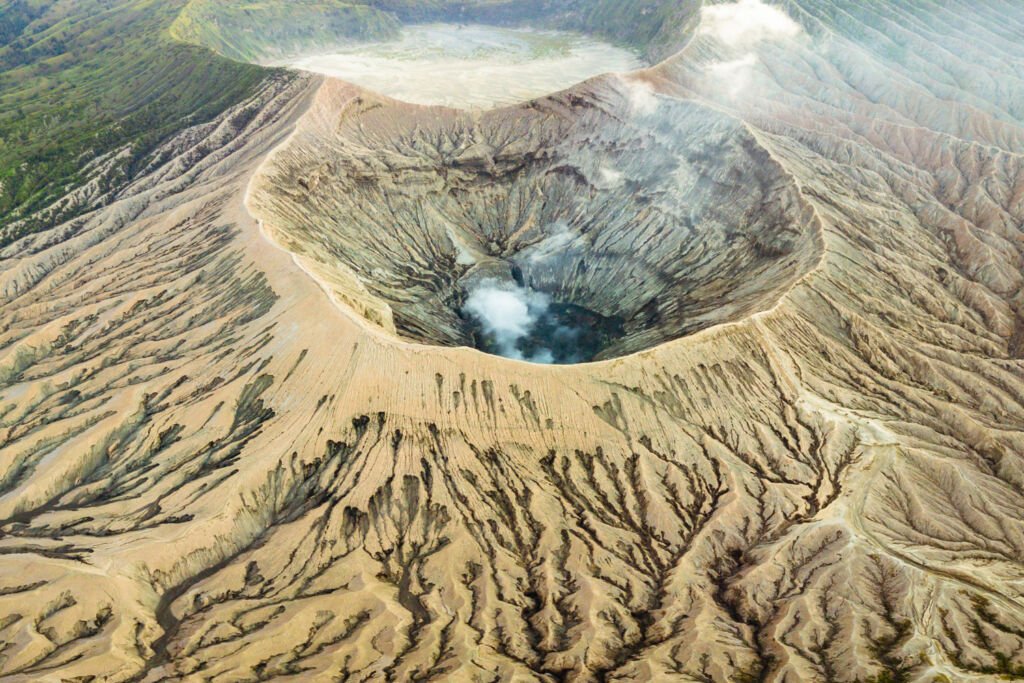
5. Lava Flows and Lava Fields:
When lava pours out of a volcano and travels over the ground, it forms lava flows. Once solidified, these flows can create extensive lava fields, shaping the surrounding landscape.
6. Volcanic Plateaus:
Formed by successive outpourings of lava over large areas, these flat-topped plateaus are built up over time by layers of lava accumulating on top of each other.
7. Fumaroles and Geothermal Areas:
Fumaroles are vents where volcanic gases are released. These areas are often associated with geothermal activity, like hot springs and geysers, resulting from heated groundwater.
8. Tuff Rings and Maar Volcanoes:
These are shallow, broad craters often filled with water, formed by phreatomagmatic eruptions (interactions between magma and water). The surrounding ring of debris (tuff) is ejected during the eruption.
9. Volcanic Necks or Plugs:
Formed when magma solidifies within the vent of an active volcano. Over time, erosion removes the surrounding rock, leaving the harder, resistant volcanic neck exposed.
10. Pyroclastic Flows and Deposits:
Pyroclastic flows are fast-moving currents of hot gas and volcanic materials (like ash and pumice) that flow down the sides of a volcano during explosive eruptions. The deposits from these flows can form significant landforms.
⫸ Effects of Volcanism:
Volcanism has a range of effects on the environment, climate, and human societies. These effects can be both positive and negative:
◆ Positive Effects:
a. Fertile Soils:
Volcanic materials, particularly ash, can break down to form highly fertile soils, which are excellent for agriculture. Regions around volcanoes often support thriving agricultural communities due to this fertility.
b. Mineral Resources:
Many minerals, including copper, gold, silver, and diamond, are associated with volcanic processes. Geothermal energy, a renewable resource, is also harnessed in volcanic areas.
c. Land Formation:
Volcanoes play a crucial role in shaping landscapes. They create islands, mountains, and other landforms, contributing to geographical diversity.
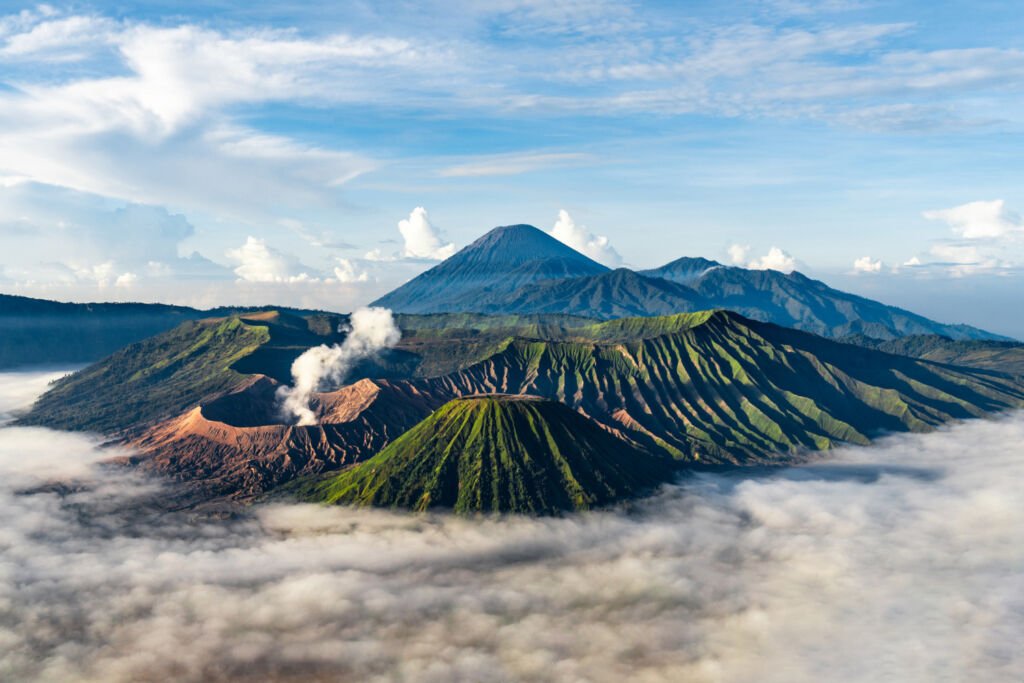
d. Tourism:
Many volcanic landscapes become tourist destinations due to their spectacular scenery and unique geological features. This can significantly boost local economies.
e. Scientific Research:
Studying volcanoes and volcanic activity provides valuable insights into Earth’s geology, helping us understand past climate changes and predict future volcanic activity.
f. Atmospheric Effects:
Volcanic eruptions can impact global climate. For instance, sulfur dioxide released during eruptions can form sulfate aerosols in the atmosphere, which reflect solar radiation and can lead to temporary global cooling.
g. Underwater Volcanism and its Hydrothermal Activity:
Hydrothermal activity of underwater volcanoes plays a very important role in marine biogeochemical cycles.
◆ Negative Effects:
a. Eruptions and Lava Flows:
Volcanic eruptions can be devastating, destroying property, infrastructure, and landscapes. Lava flows can engulf entire communities.
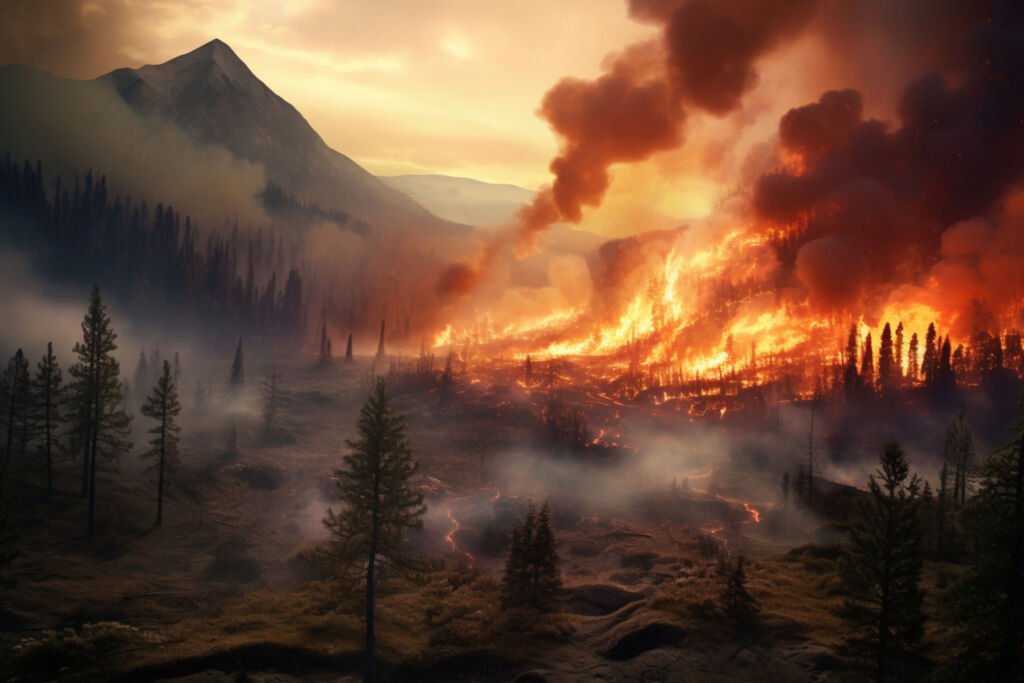
b. Ash Fall:
Volcanic ash can blanket areas, disrupting agriculture, damaging machinery, collapsing buildings, and causing respiratory health problems.
c. Pyroclastic Flows
These fast-moving currents of hot gas and volcanic material can be extremely destructive and deadly, obliterating everything in their path.
d. Lahars:
Volcanic mudflows (lahars) can occur when volcanic ash and debris mix with water, devastating valleys and communities downstream.
e. Tsunamis:
Volcanic eruptions can trigger tsunamis, especially when a volcano explosively erupts or collapses into the sea.
f. Air Travel Disruption:
Ash clouds from volcanic eruptions can disrupt air travel over large areas, as ash can damage jet engines and reduce visibility.
g. Climate Impact:
Large-scale eruptions can inject significant amounts of ash and gases into the atmosphere, affecting weather patterns and potentially leading to short-term climate changes.
h. Health Risks:
Volcanic gases like sulfur dioxide, carbon dioxide, and hydrogen sulfide can pose serious health risks to humans and animals, particularly for people living near active volcanoes.
i. Habitat Loss:
Eruptions can lead to the loss of wildlife habitats, affecting the region’s biodiversity.
j. Economic Costs:
The economic impact of volcanic eruptions can be substantial, including the costs of evacuation, rebuilding, and lost revenue from agriculture and tourism.
⫸ Recent Discoveries about Volcanoes:
1. Discovery of a Massive Ancient Eruption in the Aegean Sea:
An international team of scientists led by Dr. Steffen Kutterolf and Dr. Timothy Druitt discovered evidence of a colossal submarine eruption around Santorini, dating back approximately 520,000 years. This eruption was significantly larger than previously known eruptions in the area, including Santorini’s Late Bronze Age eruption.
The team used various methods, including micropalaeontology and electron microprobe analysis, to study the volcanic deposits and understand the magnitude of this ancient eruption.
2. Following the eruption of the Hunga Tonga-Hunga Ha'apai volcano on January 15, 2022:
A study from the Harvard John A. Paulson School of Engineering and Applied Sciences (SEAS) and the University of Maryland, published in the Proceedings of the National Academy of Sciences (PNAS), revealed that there was a considerable depletion of the ozone layer, with losses of up to 7% over extensive areas of the Southern Hemisphere.
3. A recent study featured in the journal Geophysical Research Letters has unveiled a remarkable aspect of the 2022 Hunga Volcano eruption. The research findings indicate that the volcanic plume produced during this event generated the highest rates of lightning flashes ever recorded.
4. As of December 15, 2023, there were 47 volcanoes worldwide classified as being in a state of ongoing eruption. It’s important to note that being in a “continuing” eruption status doesn’t necessarily imply constant, daily activity. Rather, it refers to volcanoes that have shown at least some intermittent eruptive events without pausing for three months or longer.
5. Recent research has shed light on the possibility of volcanic activity on Mars, particularly in an area known as Elizabeth Planitia. Scientists have estimated that this region might have experienced volcanic activity as late as within the past 120 million years.
⫸ Conclusion:
In conclusion, the study of volcanoes, or volcanology, reveals a complex and dynamic aspect of Earth’s geology. This ongoing activity underlines the importance of continuous monitoring and research to better understand and predict volcanic behavior, which is crucial for mitigating risks to human populations and the environment.
Overall, the field of volcanology not only unravels the mysteries of Earth’s interior but also plays a pivotal role in addressing some of the most pressing environmental challenges of our time. The ongoing research and discoveries continue to expand our knowledge and offer new solutions, demonstrating the ever-evolving and fascinating nature of volcanology.

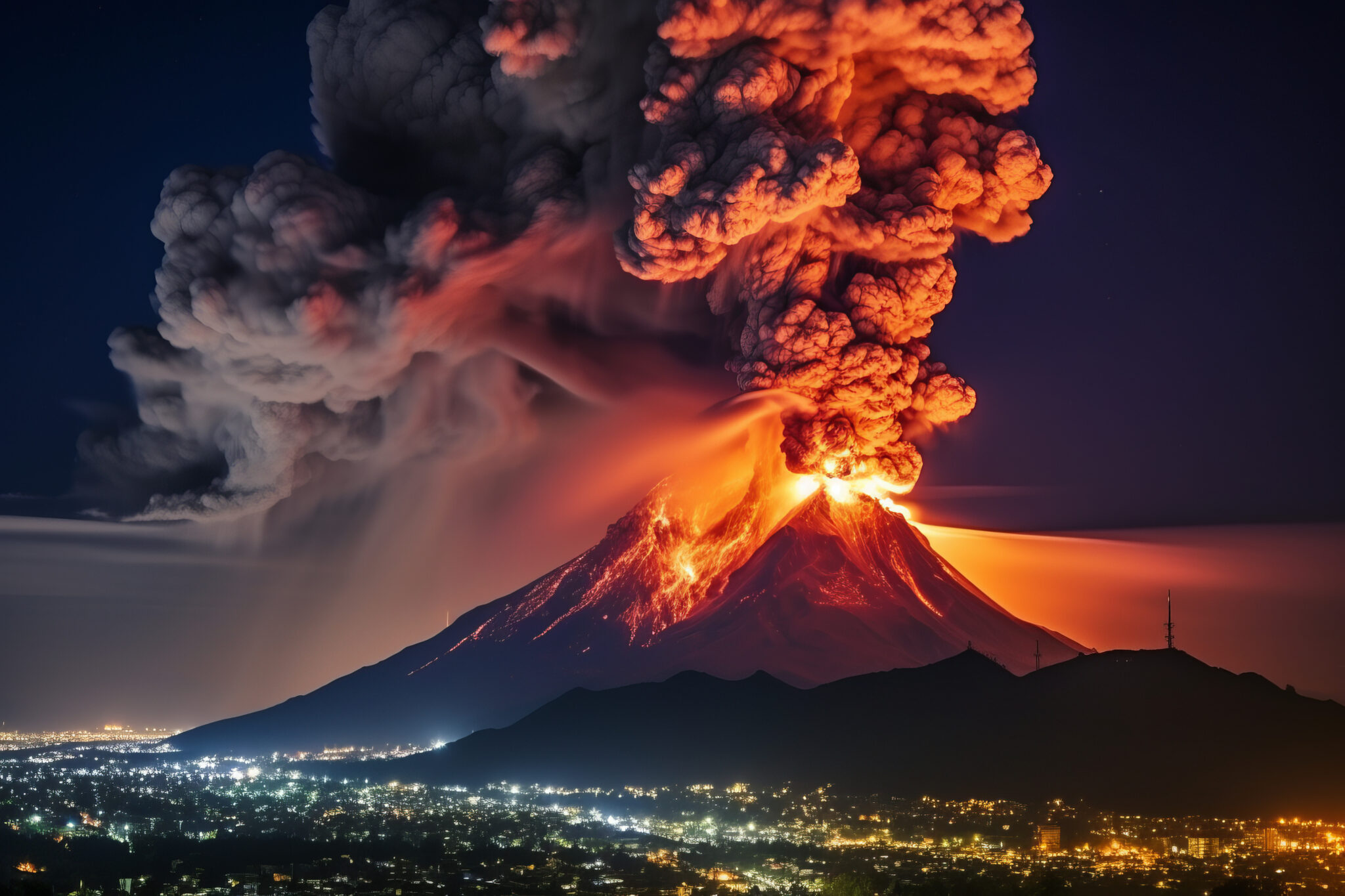
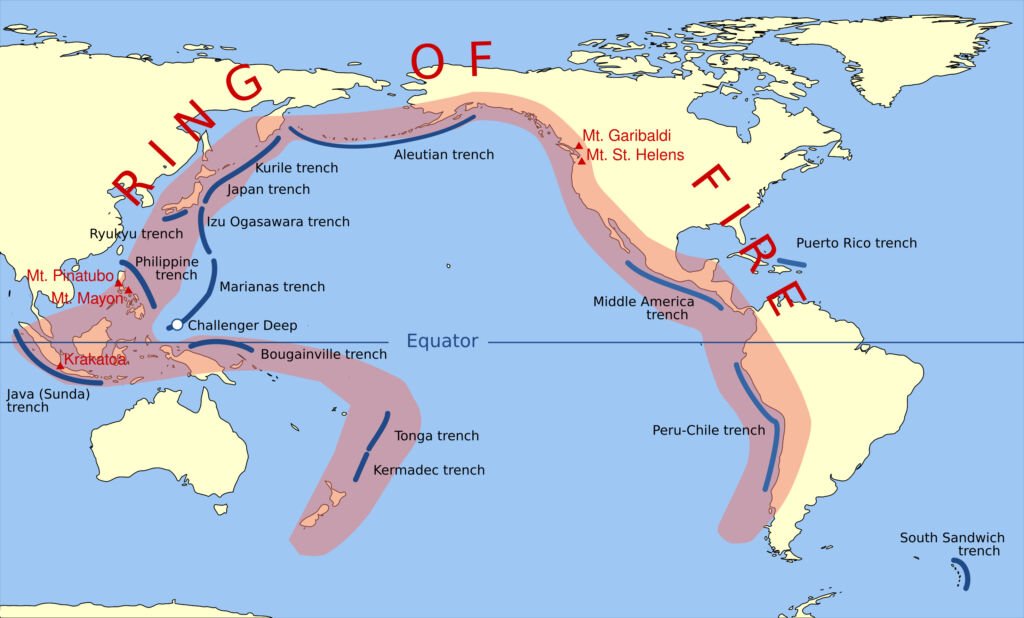
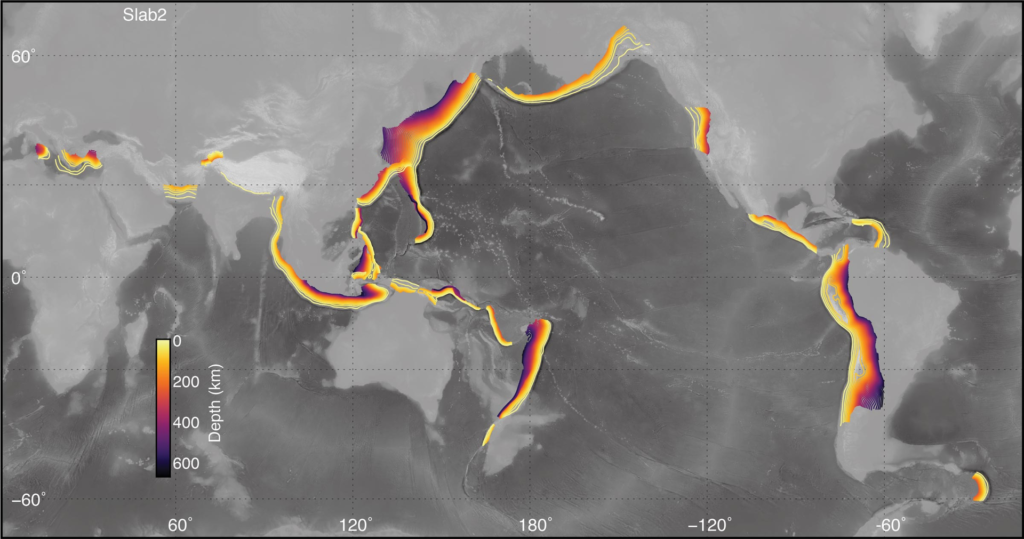
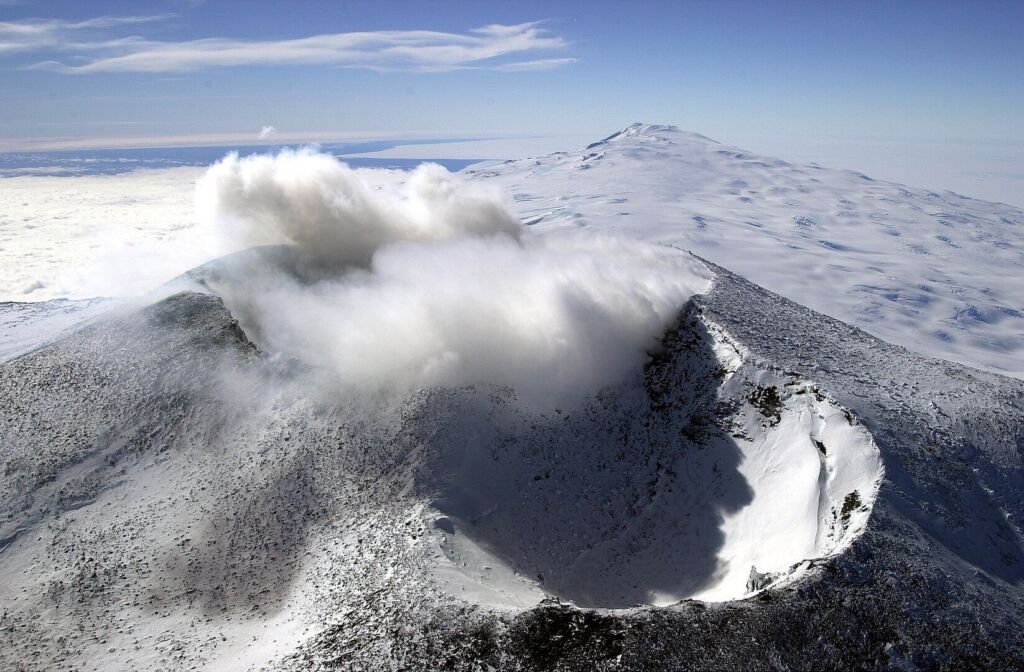
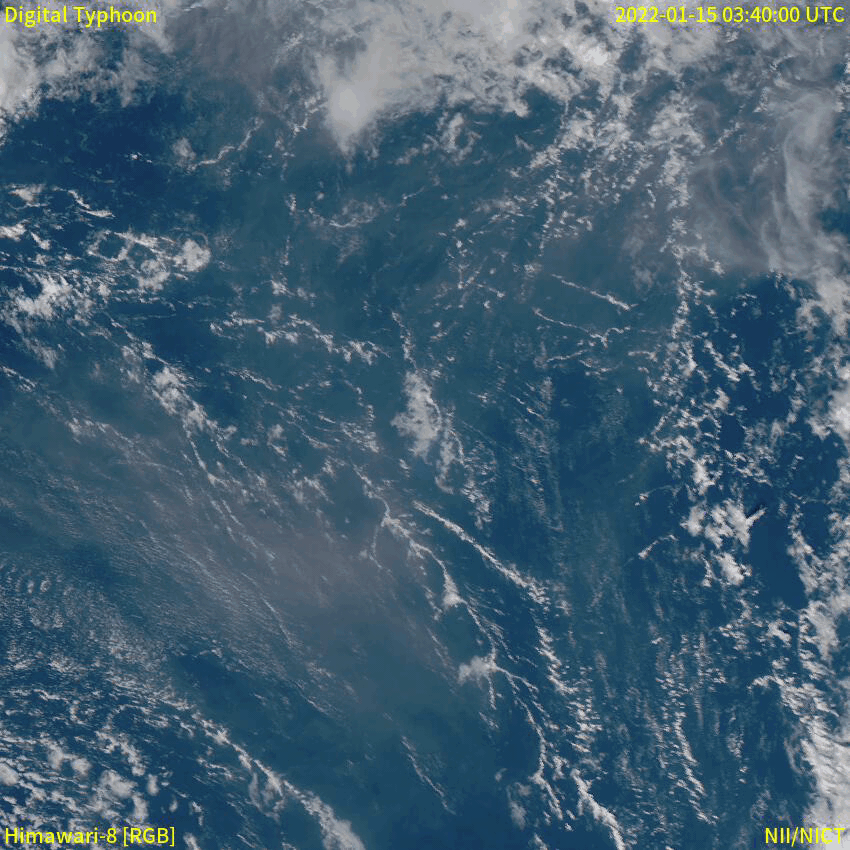
Seeing how much work you put into it was really impressive. But even though the phrasing is elegant and the layout inviting, it seems like you are having trouble with it. My belief is that you ought to try sending the following article. If you don’t protect this hike, I will definitely come back for more of the same.
Thank you for your thoughtful feedback and for recognizing the effort we put into our work. We’re glad to know that you find the phrasing elegant and the layout inviting. Our team works hard to create content that is both informative and visually appealing, so it’s rewarding to hear positive comments about these aspects.
Could you please elaborate on the specific areas where you feel we could improve? Any specific feedback or recommendations would be greatly appreciated and taken into consideration for our future content.
We’re encouraged by your willingness to return for more content, and we promise to keep working towards making our blog even better. Our aim is to create a space where readers like you can enjoy and learn from our articles, and your engagement is a crucial part of that journey.
Thank you once again for your support and constructive feedback. We look forward to welcoming you back to ‘Let’s Talk Geography’ and hope our future content will exceed your expectations.